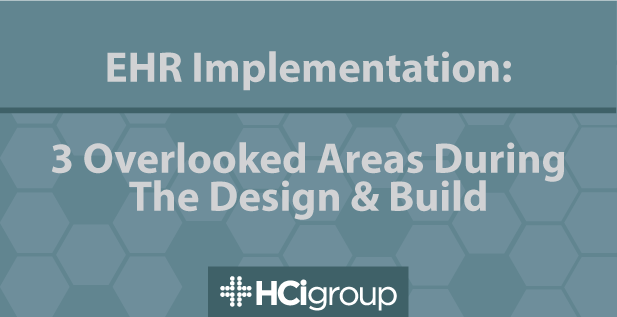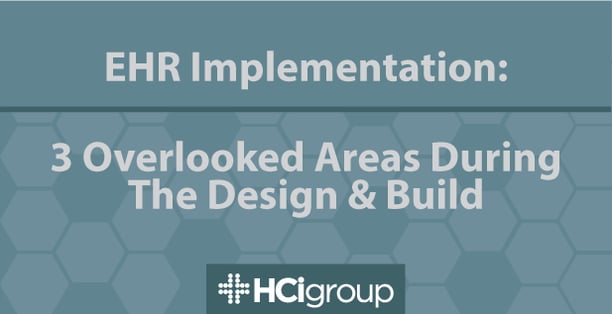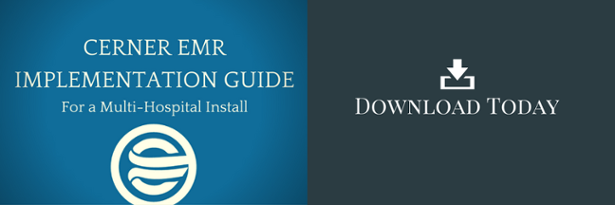EHR Implementation: 3 Overlooked Areas During the Design & Build


Over the last decade, there has been an upward trend in hospitals forming partnerships and merging into larger hospital organizations. According to the American Hospital Association (AHA), there are 5,627 U.S. Registered Hospitals. Of those, 4,802 are Community Hospitals in a System or Network. Community hospitals are defined as all nonfederal, short-term general, and other special hospitals. In today’s blog post, Cindy Klukas, an Epic Consultant for HCI, covers three areas that go into implementing an EHR for hospital systems and networks.
Most organizations choose an EHR system based on key features, ease of use, and hardware compatibility/current infrastructure, to name a few. However, organizations do not typically consider how system and network differences both can and do affect the construction of an efficient and fully-functional EHR. Once organizations select an EHR, the vendor often suggests adopting the “Foundation” build to ensure that future upgrades and development are more streamlined, with less workload for the build teams.
Unfortunately, vendors do not always account for the specialized workflows or patient demographics that some hospitals are faced with. Hospital systems and networks are finding that the concept of designing and building from the Foundation System is not always practical for their organizational needs. Below are some key lessons learned in building an EHR for a hospital system or network that are often times overlooked in the initial phase of design and build.
1) Having a Diverse Pool of Provider Types
Healthcare facilities must ensure a diverse involvement of provider types in the initial design and build of the system. There is often a larger focus on Physician and Nurse Champion’s involvement, especially when it comes to building out specialty modules (i.e. Obstetrics, Anesthesia, and Emergency Department). The downfall of not including a diverse range of healthcare workers/providers in the process is there are often workflows that are overlooked, geographic considerations not accounted for, or differences in practice guidelines that are not initially identified.
For example, Certified Registered Nurse Anesthetists (CRNAs) are able to practice under more lenient guidelines in some States, whereas CRNAs in other States have more restrictive guidelines. Build teams will oftentimes build alerts and hard stops based off of Foundation or standardized practices, which inevitably cause issues during go-live, and leads to increased user anxiety and dissatisfaction about the functionality of the system.
2) Taking Patient Demographics into Consideration
Organizations must also take into consideration the patient demographic each affiliate hospital/practice serves. Often, the EHR is built using Foundation guidelines, and considers the most common workflows and practices. For example, a Level 1, 2 or 3 Trauma Center in an urban area may not provide the same type of care as a Level 1 or 2 Trauma Center in a rural area. Build teams generally struggle with the best approach to building the EHR to accommodate the needs of the entire organization, which can lead to customized builds and more maintenance in the long run.
The top approach is to examine all workflows and best practices across each affiliate hospital, and build the system to accommodate the most robust workflow. In general, the smaller hospitals and practices can adjust to more documentation rather than less.
3) Utilizing Proper Organizational Framework
It will also be necessary to ensure that the proper infrastructure is in place to accommodate a new EHR implementation. Organizations that implement all modules of an EHR at one time typically identify issues with infrastructure early in the process, however, organizations implementing an EHR in stages typically encounter issues after they have decided to bring up a particular module.
The core build team should consider key items such as server space, possible connectivity issues, medical equipment and ability to integrate, supply and medication dispensing equipment, medication pumps, and any future purchases of new equipment or third-party systems before they begin to build and engage the provider champions. Getting infrastructure issues resolved prior to engaging the key stakeholders in the project will help ensure end user buy-in and satisfaction.
As organizations continue to merge and grow, IT analysts working in these organizations will continue to experience challenges with EHR implementations. Having a proactive approach toward identifying and resolving these issues early on will help to avoid project delays and possible additional costs.
For more information on what goes into an EHR Implementation, make sure to subscribe to our Podcast Series, and to check out our episodes with David Chou and Kelly Dungee.



